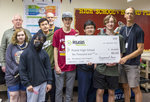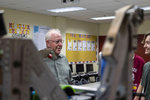

The CloverBots 3674 robotics program at Prairie High School recently received a $10,000 grant through the annual Pegasus Award.
The award is given out by Kent-based company Saxton Bradley, Inc., which designs furniture for schools across the country, according to a news release.
At a ceremony held at Prairie High School’s career center, the CEO of the business, Raymond Near, said the grant application stood out due to the teacher’s passion for its program and students.
The CloverBots program is run by photography teacher Todd Ferris, who is a former engineer who came out of retirement to teach.
“You guys are the future,” Near said to the students who gathered to commemorate the award. “You are the people who will be driving this country 15 or 20 years from now.”
The CloverBots club accepts students from across the district who are interested in robotics, engineering, design and technology.
Last year, the students were able to work together in-person to build a robot for the FIRST Robotics competition for the first time since the COVID-19 pandemic started. They ended up securing second place in the regional competition at the Oregon State Fairgrounds, stated the release.
“It was a lot of fun,” said Prairie junior Noah Pape, who will enter his second year with the program. “Especially when you get into the competition, there’s just something to it that’s exciting.”
Ferris and lead program mentor Scott Femling, who is also a retired engineer, plans to use the $10,000 to help rebuild the robotics program.
“It takes a lot of money to take part in competitions like this,” Ferris stated in the release. “You have to buy all the parts and materials and pay entrance fees to the competitions, so this grant will go a long way toward building this program and making it viable for years to come.”
Femling said they intend to keep the size of the team relatively small so students can get to experience all of the aspects of designing a robot. That includes computer-aided design, milling, electronics, programing, assembly and strategic planning, stated the release.
“From my experience in the engineering field, the challenge that they give these kids over seven weeks is harder than I gave engineers at HP,” Femling stated in the release. “You get the challenge and then you have to take them through the whole design process starting from scratch.”
The FIRST Robotics competition gives students a chance to tackle a project similar to what they will face if they pursue a career in engineering, Ferris stated in the release.
“Throughout the rest of the year students are working on smaller projects that are designed to succeed,” Ferris said. “This competition is three months. The robot may work or it may not. It involves all the aspects of design, so it’s really challenging, and it’s the only program I’m aware of that incorporates all of that.”